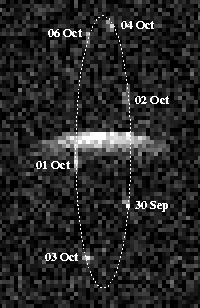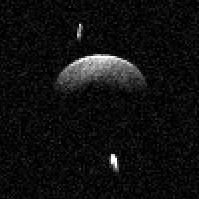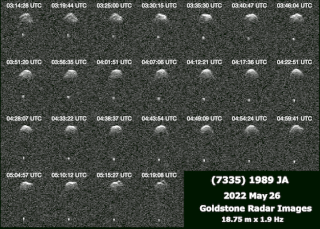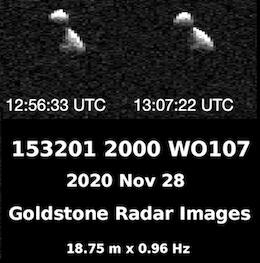
(29075) 1950 DA, provisional designation 1950 DA, is a risk-listed asteroid, classified as a near-Earth object and potentially hazardous asteroid of the Apollo group, approximately 1.1 kilometers in diameter. It once had the highest known probability of impacting Earth. In 2002, it had the highest Palermo rating with a value of 0.17 for a possible collision in 2880. Since that time, the estimated risk has been updated several times. In December 2015, the odds of an Earth impact were revised to 1 in 8,300 (0.012%) with a Palermo rating of −1.42. As of 2022, It is listed on the Sentry Risk Table with the second highest cumulative Palermo rating of −2.05. 1950 DA is not assigned a Torino scale rating, because the 2880 date is over 100 years in the future.

1620 Geographos, provisional designation 1951 RA, is a highly elongated, stony asteroid, near-Earth object and potentially hazardous asteroid of the Apollo group, with a mean-diameter of approximately 2.5 km (1.6 mi). It was discovered on 14 September 1951, by astronomers Albert George Wilson and Rudolph Minkowski at the Palomar Observatory in California, United States. The asteroid was named in honor of the National Geographic Society.
2063 Bacchus, provisional designation 1977 HB, is a stony asteroid and near-Earth object of the Apollo group, approximately 1 kilometer in diameter. The contact binary was discovered on 24 April 1977, by American astronomer Charles Kowal at the Palomar Observatory in California, United States. It was named after Bacchus from Roman mythology.

1566 Icarus is a large near-Earth object of the Apollo group and the lowest numbered potentially hazardous asteroid. It has is an extremely eccentric orbit (0.83) and measures approximately 1.4 km (0.87 mi) in diameter. In 1968, it became the first asteroid ever observed by radar. Its orbit brings it closer to the Sun than Mercury and further out than the orbit of Mars, which also makes it a Mercury-, Venus-, and Mars-crossing asteroid. This stony asteroid and relatively fast rotator with a period of 2.27 hours was discovered on 27 June 1949, by German astronomer Walter Baade at the Palomar Observatory in California. It was named after the mythological Icarus.
4486 Mithra, is an eccentric asteroid and suspected contact-binary, classified as near-Earth object and potentially hazardous asteroid, approximately 2 kilometers in diameter. It belongs to the Apollo group of asteroids and is a relatively slow rotator.
(52760) 1998 ML14, provisional designation 1998 ML14, is a stony asteroid, classified as near-Earth object of the Apollo group and potentially hazardous asteroid, approximately 1 kilometer in diameter. It was discovered on 24 June 1998, by the LINEAR survey at the Lincoln Laboratory's Experimental Test Site in Socorro, New Mexico.

66391 Moshup, provisional designation 1999 KW4, is a binary asteroid, classified as a near-Earth object and potentially hazardous asteroid of the Aten group, approximately 1.3 kilometers in diameter. It was discovered on 20 May 1999, by Lincoln Near-Earth Asteroid Research (LINEAR) at the Lincoln Laboratory's Experimental Test Site in Socorro, New Mexico, United States. It is a Mercury-crosser that comes extremely close to the Sun at a perihelion of 0.2 AU.

Elsa is a Massalia or background asteroid from the inner regions of the asteroid belt, approximately 44 kilometers in diameter. It was discovered on 7 February 1878, by Austrian astronomer Johann Palisa at the Austrian Naval Observatory in today's Croatia. The S-type asteroid has a very long rotation period of 80 hours and likely an elongated shape. The origin of its name is uncertain.

1627 Ivar, provisional designation 1929 SH, is an elongated stony asteroid and near-Earth object of the Amor group, approximately 15×6×6 km. It was discovered on 25 September 1929, by Danish astronomer Ejnar Hertzsprung at Leiden Southern Station, annex to the Johannesburg Observatory in South Africa. It was named after Ivar Hertzsprung, brother of the discoverer. 1627 Ivar was the first asteroid to be imaged by radar, in July 1985 by the Arecibo Observatory.
2340 Hathor, provisional designation 1976 UA, is an eccentric stony asteroid, classified as near-Earth object and potentially hazardous asteroid. It belongs to the Aten group of asteroids and measures approximately 210 meters in diameter. Discovered by Charles Kowal in 1976, it was later named after the ancient Egyptian goddess Hathor.

(185851) 2000 DP107 is a sub-kilometer sized asteroid, classified as potentially hazardous asteroid and near-Earth object of the Apollo group that is notable because it provided evidence for binary asteroids in the near-Earth population. The PROCYON probe developed by JAXA and the University of Tokyo was intended to flyby this asteroid before its ion thruster failed and could not be restarted.

(153591) 2001 SN263 is a carbonaceous trinary asteroid, classified as near-Earth object and former potentially hazardous asteroid of the Amor group, approximately 2.6 kilometers (1.6 miles) in diameter. It was discovered by the Lincoln Near-Earth Asteroid Research project at Lincoln Lab's Experimental Test Site in Socorro, New Mexico, on 20 September 2001. The two synchronous minor-planet moons measure approximately 770 and 430 meters and have an orbital period of 16.46 and 150 hours, respectively.

(450894) 2008 BT18 is a sub-kilometer asteroid and synchronous binary system, classified as near-Earth object and potentially hazardous asteroid of the Apollo group. It was discovered on 31 January 2008, by the LINEAR program at Lincoln Laboratory's Experimental Test Site near Socorro, New Mexico, United States. The eccentric asteroid measures approximately 600 meters in diameter and has a composition of a basaltic achondrite.

(7335) 1989 JA, provisional designation 1989 JA, is a stony asteroid of the Apollo group, classified as near-Earth object and potentially hazardous asteroid, approximately 1 kilometer in diameter. It was discovered on 1 May 1989, by American astronomer Eleanor Helin at the U.S. Palomar Observatory in California. On 27 May 2022, the asteroid made a close approach 0.027 astronomical units from Earth. During the close approach, optical observations detected signs of an orbiting satellite, which was later confirmed by radar imaging at NASA's Goldstone Solar System Radar in California.

(153201) 2000 WO107 is a sub-kilometer asteroid, classified as near-Earth object and potentially hazardous asteroid of the Aten group with a very well determined orbit. It was discovered on 29 November 2000, by astronomers of the Lincoln Near-Earth Asteroid Research (LINEAR) at the Lincoln Laboratory's Experimental Test Site near Socorro, New Mexico, in the United States. It is a contact binary.
(162421) 2000 ET70 is a dark, elongated and oblate asteroid, classified as near-Earth object and potentially hazardous asteroid of the Aten group, approximately 2.2 kilometers in diameter. It was discovered on 8 March 2000, by astronomers of the Lincoln Near-Earth Asteroid Research at the Lincoln Laboratory's Experimental Test Site near Socorro, New Mexico. The body has a notably low albedo, and its shape resembles that of a "clenched fist".

(52768) 1998 OR2 (provisional designation 1998 OR2) is an asteroid on an eccentric orbit, classified as a near-Earth object and potentially hazardous asteroid of the Amor group, with a diameter of 2 kilometers (1.2 mi). It was discovered on 24 July 1998, by astronomers of the Near-Earth Asteroid Tracking (NEAT) program at the Haleakala Observatory, Hawaii. It is one of the brightest and therefore largest potentially hazardous asteroids known to exist. With an observation arc of 35 years, the asteroid has a well-determined orbit, and its trajectory is well known through the year 2197. The asteroid's orbit is only potentially hazardous on a time scale of thousands of years.
(143651) 2003 QO104, provisional designation 2003 QO104, is a stony asteroid, slow rotator and suspected tumbler on a highly eccentric orbit, classified as near-Earth object and potentially hazardous asteroid of the Amor and Apollo group, respectively. It was discovered on 31 August 2003, by astronomers of the Near-Earth Asteroid Tracking program at the Haleakala Observatory in Hawaii, United States. The Q-type asteroid has a rotation period of 114.4 hours and possibly an elongated shape. It measures approximately 2.3 kilometers (1.4 miles) in diameter and belongs the largest potentially hazardous asteroids known to exist.
(385343) 2002 LV, provisional designation 2002 LV, is a stony asteroid on a highly eccentric orbit, classified as near-Earth object and potentially hazardous asteroid of the Apollo group, approximately 1.5 kilometers in diameter. It was discovered on 1 June 2002, by astronomers with the Lincoln Near-Earth Asteroid Research at the Lincoln Laboratory's Experimental Test Site near Socorro, New Mexico, in the United States. The Sr-type asteroid has a rotation period of 6.2 hours and is likely elongated.
(154276) 2002 SY50, provisional designation 2002 SY50, is a stony asteroid on a highly eccentric orbit, classified as near-Earth object and potentially hazardous asteroid of the Apollo group, approximately 1.1 kilometers (0.7 miles) in diameter. It was discovered on 30 September 2002, by astronomers with the Lincoln Near-Earth Asteroid Research at the Lincoln Laboratory's Experimental Test Site near Socorro, New Mexico, in the United States. The K-type asteroid has a rotation period of 4.8 hours. It will make a close encounter with Earth on 30 October 2071.














